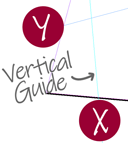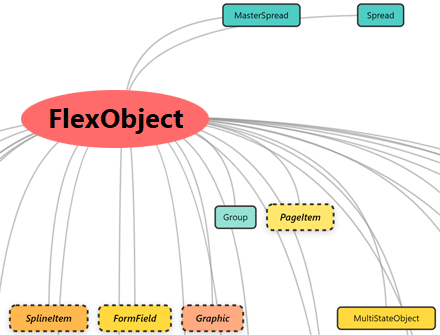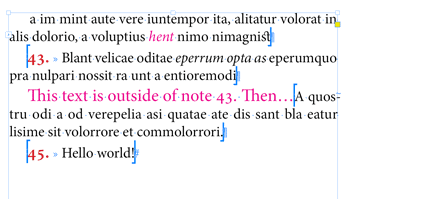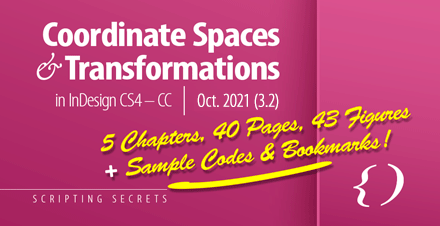Tips
Scripters corner: howtos, tips and tricks for automating complex InDesign tasks.FlexObject (InDesign 2026) on the Scripting Side
ByteStream: Your Swiss Army Knife for Binary Data in InDesign Scripts
September 30, 2025 | Tips | en | fr
Gone are the days of manually parsing bytes and wrestling with endianness! ByteStream (a powerful addition to the IdExtenso framework) introduces a declarative format string syntax that lets you read complex binary structures in a few lines of code. Whether you're extracting metadata from font files or parsing proprietary formats, ByteStream transforms hours of painstaking byte manipulation into readable code…
InDesign 20 Goes to MathML — Part 2
March 23, 2025 | Tips | en
In the first part of this paper, we explored the basics of MathML and how it's incorporated into InDesign's Math Expressions panel. For script developers working with ExtendScript and/or UXP, the underlying SVG structure requires further investigation. This will lead us to intriguing issues and potential challenges…
Let's Play with JS Array Objects (in ExtendScript)
September 14, 2024 | Tips | en | fr
IdExtenso provides a new ArrayAs2D module that unleashes the hidden strengths of ExtendScript operators. With this toy, you can now write code that adds, multiplies, evaluates 2D points or vectors. For example, if you develop an InDesign script based on Bézier curves or working on polygonal paths, all calculations of points, distances, normalized vectors, etc. become wonderfully compact…
Make `&` (almost) Behave as a Reference Operator
August 09, 2024 | Tips | en
Suppose you have an ExtendScript class (I mean, “prototype”) whose methods essentially return new object instances. As an obvious example, consider the concat or slice methods of Array.prototype. They always produce a new array rather than reworking the existing one. There are situations where you want to update the calling object —and make this explicit in the code— while still leveraging the methods already available…
Built-In String Features in IdExtenso
March 29, 2024 | Tips | en
If you are one of the happy users of the IdExtenso scripting framework for InDesign, you may have noticed — or overlooked! — that this enhanced version of ExtendScript provides many additional services, including in the primitive areas of the language. For example, any string immediately has functionalities like trim(), codePointAt(), toUTF8(), which aren't available in the root syntax. Let's take a closer look at this toolbox…
Scripting: How to Position InDesign Guides
December 03, 2023 | Tips | en
 InDesign guides are funny creatures. Whether or not they are assigned to a page via the
InDesign guides are funny creatures. Whether or not they are assigned to a page via the fitToPage property, they remain firmly anchored to the geometry of the spread they belong to. The most mysterious thing is their location attribute, which does not obey all the principles ordinarily weighing on rulers coordinates. This article explores how to determine correct positions in all scenarios…
InDesign Scripting: Why are Endnotes so Hard to Decipher?
June 03, 2023 | Tips | en
The Magic Parent Bounding Box
August 04, 2022 | Tips | en
 Geometry in InDesign can get deadly complex. Take a document, create a frame, insert a table, change a particular cell into a “graphic cell,” convert its inner object into an ellipse, play with strokes, rotate and scale the object, transform the parent frame in the fanciest way. Then ask yourself the question: what are the exact coordinates, shape or area of the final table cell?…
Geometry in InDesign can get deadly complex. Take a document, create a frame, insert a table, change a particular cell into a “graphic cell,” convert its inner object into an ellipse, play with strokes, rotate and scale the object, transform the parent frame in the fanciest way. Then ask yourself the question: what are the exact coordinates, shape or area of the final table cell?…
The Case of Converting InDesign Inches to Ciceros
July 26, 2022 | Tips | en
While working on his Measurements scripts, my colleague Mikhail Ivanyushin reported me weird biases related to units conversion. In particular, he observed a discrepancy between InDesign's display and direct results from ExtendScript when addressing inches-to-ciceros translation…
The Hard Problem of Quantified Alternatives in ExtendScript
January 21, 2022 | Tips | en
In most cases, ExtendScript regular expressions cannot digest the (a|b)+ scheme. This bug is not new, but it's worth defining its symptoms and extent. This article presents a very simple problem, with no known solution to date…
Porting your InDesign Script into IdExtenso — Step 5
October 19, 2021 | Tips | en
In this episode we seriously improve the relationship between user settings and user interface. As a result, we get a smart InDesign script that both remembers the choices the user made within the session and adapts to the context, that is, whether the script should target the selection or a larger scope…
Coordinate Spaces & Transformations in InDesign [UPDATE]
October 14, 2021 | Tips | en
Coordinate Spaces & Transformations is a free eBook covering all atomic subjects that a InDesign scripter or developer should grab before using transformation matrices and the related methods. The last update has minor corrections and notes…
Porting your InDesign Script into IdExtenso — Step 4
October 09, 2021 | Tips | en
The previous episode dealt with modularity in IdExtenso, now is the time to take full advantage of it! Today we will see how to add a dialog interacting with user options. You will be amazed at how quickly this component fits into the script…
Porting your InDesign Script into IdExtenso — Step 3
September 24, 2021 | Tips | en
In this episode, you will learn how to arrange your code so that it fits into IdExtenso's “modular space.” Modularity is a key term when it comes to maintaining a large-scale project. Even if our sample script is not in itself of pharaonic complexity, we will transform it, as an exercise, into a pure module…
Porting your InDesign Script into IdExtenso — Step 2
September 15, 2021 | Tips | en
Today we will embed in IdExtenso the code we prepared in the previous episode. That's of course an important move, especially when you perform it for the very first time (since then you need to install the framework.) But you will discover in what follows the immediate advantages that $$ offers you…
Porting your InDesign Script into IdExtenso — Step 1
September 07, 2021 | Tips | en
So, you have the root idea and a basic code for your next InDesign script. All is fine. It works so well that you're now planning to release it, which opens additional questions: Will it work everywhere? How do I trace risky functions? What if I need to integrate new features later on? How do I deal with persistent user settings? How to add a basic interface? How will I localize the dialog in other languages? Can I make my script available in a dedicated menu? Will it work in a JSXBIN package as well? Can I obfuscate my code?…
Page Range Formatter [UPDATE]
August 17, 2021 | Tips | en
Given an unordered set of page numbers—e.g. {13, 9, 25, 12, 11, 8}—we often have to compute and output a range specification in the form "8-9; 11-13; 25". While this topic has been already discussed in the InDesign scripting forum, I'd like to explore today a slightly different approach…
« previous entries - Page 1 of 4





